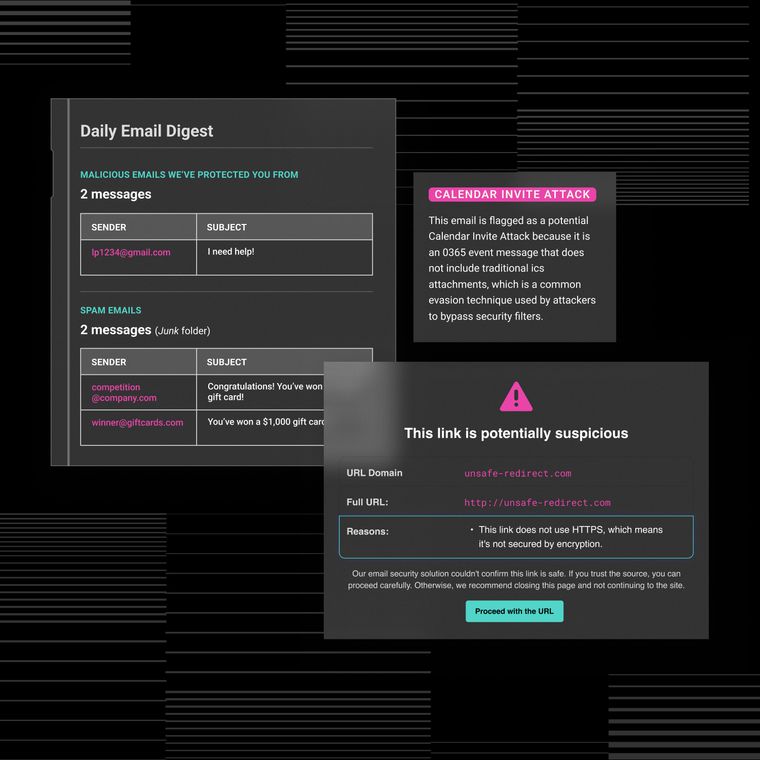How Many Cyberattacks Happen Per Day? Here's the Impact They Have
Discover the daily volume of cyber attacks, their impact on businesses, and how to prioritize your defenses effectively.
July 15, 2025
Roughly hundreds of millions of cyberattack attempts are detected and prevented every day worldwide, and the global annual cost of cybercrime is projected to reach up to $10.5 trillion by 2025, making it a threat of unprecedented scale for businesses. For instance, a single phishing link in an inbox can expose personal information and siphon funds long before you decide what to do after a phishing attack.
Understanding daily attack volumes, which sectors face the most pressure, and how tactics evolve helps you safeguard every email address, device, and business process. This analysis quantifies daily threat volumes, highlights the most targeted industries, and maps the financial, operational, and regulatory impacts, enabling you to prioritize your defenses effectively.
How Many Cyberattacks Happen Daily?
Cyberattacks strike at an unprecedented scale, with Microsoft recording approximately 600 million blocked threat attempts every 24 hours. This volume represents an increase in hostile actions, creating a threat environment where malicious packets slam into networks nearly every second.
The FBI’s Internet Crime Complaint Center (IC3) received 880,418 complaints of internet crime in 2023, averaging about 2,412 complaints daily, representing reported cyber incidents impacting individuals and organizations across the US and globally. The same report also cites that $16.6 billion was the total reported cybercrime losses in 2024, the highest total ever recorded and a 33% increase over 2023.
Additionally, an IBM-sourced news report further noted that a daily average of 74,000 cyberattack attempts globally observed in 2023 (based on threat intelligence from multiple regions and sectors).
These statistics reveal that cyber attacks have evolved from isolated incidents to a relentless daily assault, with attackers successfully extracting record-breaking financial losses despite massive defensive efforts. Understanding this scale is crucial for organizations to recognize that cybersecurity isn't just an IT concern. It's a business-critical function requiring proportional investment and strategic priority.
Breaking Down the Daily Threat Landscape by Attack Type
Attackers deploy multiple vectors simultaneously such as phishing, ransomware, malware, and network disruption, requiring security teams to prioritize defenses based on frequency and impact rather than treating all threats equally. Here are the most critical attack types organizations should monitor:
Phishing and Business Email Compromise
Phishing consistently stands as the most popular attack type, accounting for 72% of all advanced email threats. It was the most reported cybercrime in 2024, with 193,407 complaints. Although the volume fell, losses surged to $70 million, nearly four times higher than the previous year.
Similarly, $2.77 billion in Business Email Compromise (BEC) losses in 2024 represented more than 17% of all financial damages across 21,442 reported incidents.
The persistence of email-based attacks stems from their scalability and exploitation of human trust, making email security investments the most effective way to reduce daily attack exposure.
Ransomware
Generative AI is supercharging cybercriminals and driving a surge in social engineering threats. According to a World Economic Forum report, in 2024, 72 % of security teams saw overall cyber risk rise, with ransomware still near the top of the list. Almost half (47 %) view generative-AI-powered tactics as the most urgent danger because they let attackers craft highly convincing, large-scale phishing and social-engineering campaigns.
Supply Chain Attacks
Denial-of-service attacks persist as both direct disruption tools and cover for more sophisticated intrusions targeting uptime-sensitive services. Supply chain compromises expanded their reach.
According to World Economic Forum, 54% large enterprises say supply-chain issues are the main obstacle to cyber-resilience. As supply chains grow more complex and vendor securityremains opaque, the risk rises. Chief worries include third-party software flaws and attacks that ripple across the entire ecosystem.
Cryptocurrency Fraud
In 2024, IC3 logged 149,686 cryptocurrency-related complaints, with total reported costs exceeding $9.3 billion, which is a 66% increase over 2023. Criminals exploited crypto in nearly every major crime category tracked, making the takeaway clear: if a fraud involves a financial transfer, there’s a good chance cryptocurrency is part of the picture.
Investment Fraud
Investment fraud caused the highest financial damage for the second straight year, racking up $ 6.57 billion in 2024, up 21 % in complaints year-over-year. Most of that loss stemmed from cryptocurrency schemes known as “pig butchering,” which drained $ 5.8 billion from 41,557 victims.
Pig-butchering scams use sustained social engineering to coax victims into funding fake crypto accounts that appear to generate healthy returns. Once the victim has deposited substantial funds, the fraudster withdraws the money, shuts down the account, and severs contact.
Who Gets Hit the Hardest? Industry-Specific Daily Exposure
Cybercriminals don't attack randomly. Rather, they strategically target industries with high-value assets, operational dependencies, and opportunities for financial or geopolitical leverage. Understanding which sectors face the greatest daily exposure helps organizations prioritize their cybersecurity investments and defensive strategies. Here is a list of most targeted industries in 2024 according IBM’s Threat Intelligence Index:
Manufacturing (26%): Remains the top target for the fourth consecutive year, primarily due to critical supply chain roles and valuable intellectual property. Attackers focus on exploiting public-facing applications (29%) and target operational disruption through ransomware.
Finance and Insurance (23%): Second most attacked sector, with phishing campaigns (30%) as the primary entry point. Attackers prioritize espionage, credential harvesting, and data theft equally (20% each).
Professional, Business, and Consumer Services (18%): Third-place sector faces server access attacks (25%) and exploitation of public-facing applications (50%). Credential harvesting (45%) and data leaks (36%) are primary impacts.
Energy (10%): Critical infrastructure sector experiences diverse attack methods, with server access, ransomware, and backdoor malware equally prevalent (8% each).
Transportation (7%): Rose from eighth place, primarily through external remote services exploitation. Data theft affects 67% of incidents.
Healthcare and Retail (5% each): Healthcare focuses on server access and ransomware, while retail faces business email compromise and backdoor attacks.
Regional Variations
Attack patterns vary significantly by geography, with APAC leading manufacturing attacks (56%), Middle East/Africa dominating finance incidents (27%), and Europe experiencing the highest professional services targeting (47%).
Organizations in high-risk industries should implement sector-specific risk assessments, enhanced monitoring, and collaborative defense strategies through industry-specific Information Sharing and Analysis Centers (ISACs) to build resilience against these persistent threats.
The Business Impact Behind the Numbers
Cyberattack incidents hit your bottom line long after the technical response is complete, driving direct losses, operational disruption, and reputational fallout that easily eclipse the initial recovery bill. Here are the common impact on business operations:
Financial Impact: Breach economics are brutal, with the average incident now costing millions worldwide. Healthcare breaches are among the most expensive, while intellectual property theft siphons hundreds of billions from firms each year. These costs come from ransom payments, direct financial theft, forensic recovery, and legal bills.
Operational Impact: Every hour offline erodes revenue, with ransomware keeping organizations down for weeks on average. Manufacturing companies have lost hundreds of millions after single attacks disabled production lines, demonstrating how downtime ripples across global supply chains. Attackers often linger undetected for months, leaving ample opportunity to deepen the damage before containment begins.
Reputational & Regulatory Impact: Trust evaporates faster than you can draft a press release. Publicly disclosed breaches routinely erase shareholder value with measurable stock-price drops in the first trading sessions after disclosure. Regulators intensify strain through multi-million-dollar penalties for lapses in data protection, while class-action litigation adds another zero to the expense column.
Why the Numbers Keep Rising
Gen AI has become every attacker's advantage, with frameworks powering AI-driven phishing kits that craft flawless, personalized emails. Your attack surface has exploded through Software as a Service (SaaS) sprawl, remote work, and always-on APIs that extend corporate boundaries into homes and third-party clouds. Commoditized ransomware-as-a-service models lower the bar for entry, while human error remains a primary vulnerability.
How Abnormal Helps You Keep Pace with Daily Cyberattacks
Cyberattacks now strike at an industrial scale, overwhelming legacy perimeter tools and exposing organizations to downtime, regulatory headaches, and reputational harm.
Shrinking detection windows, off-the-shelf ransomware kits, and AI-driven phishing demand a layered defense: staff trained to recognize social engineering, zero-trust processes that limit lateral movement, and technology that hunts anomalies across email, endpoints, and SaaS.
Abnormal’s behavioral AI learns how every employee and vendor normally communicates, then blocks deviations before a user clicks a malicious link or approves a bogus invoice. By focusing on intent instead of static indicators, Abnormal stops the high-volume email threats that fuel most breaches.
The threat landscape accelerates daily, your defenses must move faster. Explore Abnormal to turn insight into measurable risk reduction. Book a demo to learn more.
Related Posts
Get the Latest Email Security Insights
Subscribe to our newsletter to receive updates on the latest attacks and new trends in the email threat landscape.


